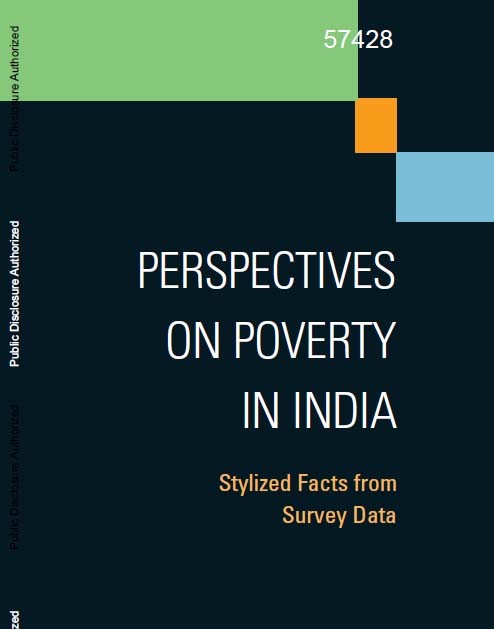 It produces a diagnosis of the broad nature of the poverty problem and its trends in India, focusing on both consumption poverty and human development outcomes.
It produces a diagnosis of the broad nature of the poverty problem and its trends in India, focusing on both consumption poverty and human development outcomes.
It also includes attention in greater depth to three pathways important to inclusive growth and poverty reduction harnessing the potential of urban growth to stimulate rural-based poverty reduction, rural diversification away from agriculture, and tackling social exclusion.
The study makes the following key points -
- India has maintained steady progress in reducing poverty as measured by consumption. Using the Government of India’s official poverty lines, in 2004–05, 28 percent of people in rural areas and 26 percent of people in urban areas lived below the poverty line, down from 47 percent and 42 percent, respectively, in 1983.
- Data issues cloud our assessment of whether the growth process has become more or less pro-poor in the post reform period. Poverty has declined and growth has tended to reduce poverty, including in the post reform period. However, the data present no robust case for saying that the responsiveness of poverty to growth has either increased or decreased since the early 1990s.
- New drivers of poverty reduction—urban growth and non-farm growth—have emerged since the 1990s. Historical evidence in India from the 1970s to the early 1990s has shown agricultural growth to be a major factor in reducing poverty. Indeed, for decades, poverty reduction in India has been synonymous with rural and, in particular, agricultural growth. But since the 1990s agriculture has lagged other sectors, shrinking in its contribution to less than half of rural GDP. That poverty reduction has continued apace despite a slowdown in agriculture points to the emergence of new drivers of poverty reduction. This report draws on survey evidence to identify two—urban growth and nonfarm growth.
- Since the 1990s, urban growth has reduced urban poverty as before, but evidence is now appearing of a much stronger link from urban growth to rural poverty as well. With nearly three-quarters of India’s poor residing in rural areas, any driver that does not affect the rural poor is unlikely to make a significant dent in Indian poverty.
- The process of rural transformation out of agriculture toward the nonfarm sector is assuming a greater role in reducing Indian poverty.
- Continued debate about the appropriate sectoral focus for poverty reduction efforts is warranted. Agriculture is still the employer of too many of India’s poor (and especially the female and elderly poor) to be ignored, but urban growth and nonfarm rural employment deserve greater attention. The rural nonfarm sector as a sustainable source of poverty reduction will need close scrutiny—the quality of nonfarm employment has been falling in a trend toward growing “casualization” of the sector. Within the urban sector, large cities may well continue to drive India’s growth.
- In contrast to consumption poverty, India’s record on improving basic health and education indicators is mixed. Although some outcomes are improving, others remain stubborn and are worse for, but not confined to, the poor.
- Inequality is on the rise and may be higher than often thought. Consumption inequality has fallen over the longer term in India but is now on the increase.
- Some types of inequality, but not all, are harmful for poverty reduction. Everything else being equal, a rise in inequality will dampen the poverty-reducing impact of an increase in mean incomes. But everything else is not equal, and some growth accelerations may not be possible without an increase in inequality.
- Structural inequalities by caste, tribe, and gender are present and visible. Scheduled tribes are being left behind.
- Improving human development outcomes for the poor remains a key challenge for India. It is central to improving their income earning opportunities and welfare. Given the recent record, it is simply not the case that continued rapid economic growth will automatically translate to commensurate improvements on human development outcomes. Larger, and systemic, challenges of service delivery remain.
Download the report here -
Posted by
Attachment





 Perspectives_on_poverty_in_India_World_Bank_2011.pdf
Perspectives_on_poverty_in_India_World_Bank_2011.pdf







